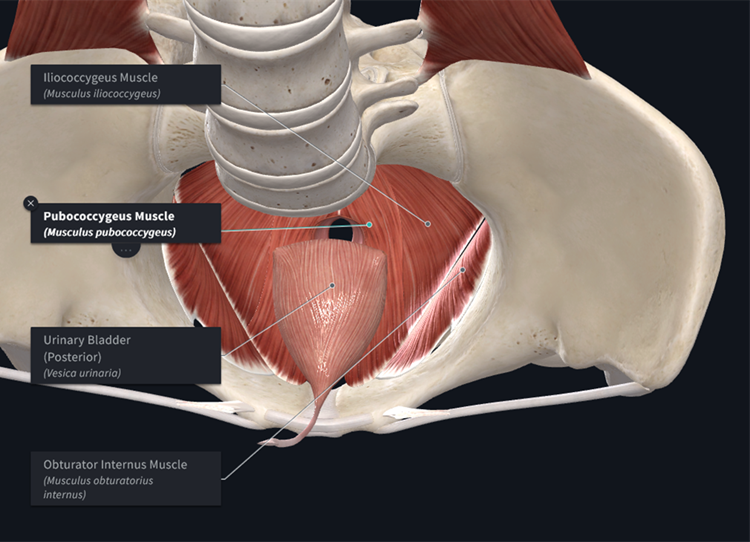Back
The Connection Between the Hips and Bladder
By Shannon Strauch, PTA, STMT-1 on 9/24/2024

When we think about bladder health, it’s easy to focus on the bladder itself. However, the complex network of muscles and structures that support the bladder plays a crucial role in its proper functioning. One of the key players in this system is the hips. Understanding the connection between the hips and bladder can open doors to addressing common issues like urinary incontinence, bladder urgency, and pelvic pain.
In this blog, we'll explore how hip health directly influences bladder function and how you can take steps to improve both through mobility exercises, strengthening, and holistic care.
1.
Anatomy of the Pelvis: The Link Between Hips and Bladder
The pelvic floor is a group of muscles that form a sling across the bottom of the pelvis, supporting the bladder, intestines, and, in women, the uterus. These muscles work in conjunction with the surrounding hip muscles, such as the obturator internus and piriformis, which attach to the pelvis. If your hips are tight, weak, or misaligned, the pelvic floor may be strained or dysfunctional, leading to bladder control issues.
For example, poor hip flexibility or muscle imbalances can cause extra pressure on the pelvic floor, impairing its ability to support the bladder. This can contribute to urinary incontinence or urgency, as the muscles may struggle to contract or relax properly.

2.
Posture and Hip Alignment’s Impact on Bladder Health
Hip alignment is closely tied to posture, and poor posture can put excess pressure on the bladder and pelvic floor. If you tend to slouch or have an anterior pelvic tilt (where your pelvis tilts forward), the bladder may be compressed, which can increase the urge to urinate or cause leakage.
Maintaining proper posture, with hips aligned over the pelvis, helps distribute weight evenly, allowing both the hip muscles and pelvic floor to work harmoniously to support bladder control.
3.
How Hip Mobility Affects the Pelvic Floor
Limited hip mobility is a common issue that can contribute to pelvic floor dysfunction. Tight hip muscles, particularly the hip flexors, can limit the range of motion in the pelvis and affect how the pelvic floor muscles engage. When these muscles are restricted, they may not be able to fully relax, which can lead to bladder issues like urinary urgency or incomplete emptying of the bladder.
Working on hip flexibility through stretching exercises like lunges, pigeon pose, or hip flexor stretches can help restore balance and mobility in the hips, relieving pressure on the bladder and improving pelvic floor function.
4.
Exercises to Strengthen Hip and Pelvic Floor Muscles
Strengthening both the hip and pelvic floor muscles is key to maintaining bladder health. Exercises that engage both sets of muscles, such as squats and bridges, help ensure that the hips and pelvic floor work together effectively. Here are a few exercises to try:
Bridges
: This exercise targets both the glutes and pelvic floor, which helps stabilize the hips and support bladder control.
Hip Flexor or Rotator Stretches
: Stretching the hip flexors and rotators can alleviate tension that may be contributing to pelvic floor tightness or bladder pressure.
Clamshells
: Strengthening the outer hip muscles can improve pelvic stability and reduce pelvic floor strain.
Regularly performing these exercises can help alleviate bladder problems and improve overall pelvic health.
5.
Common Hip and Bladder-Related Issues
Many people experience issues like hip pain or stiffness, which can directly impact bladder function. For example, people with conditions like hip osteoarthritis often report urinary problems, as the inflammation and restricted mobility in the hips can affect pelvic floor engagement.
In addition, pelvic pain syndromes, such as chronic pelvic pain syndrome (CPPS), often involve both the hip and pelvic floor muscles. Releasing tension in the hips through stretching or physical therapy can reduce pelvic pain and help normalize bladder function.
6.
Holistic Approaches to Hip and Bladder Health
To support both hip and bladder health, it’s important to take a holistic approach. Pelvic floor therapy is a proven method to treat pelvic dysfunction, but incorporating yoga, Pilates, or general mobility exercises into your routine can also be incredibly beneficial.
For example, yoga poses like child’s pose or pigeon pose can release tight hip muscles and reduce tension in the pelvic floor, helping improve bladder control. Pilates exercises that focus on core strength also target the pelvic floor and hips, promoting balance and stability in the pelvis.
Conclusion: The Hips and Bladder—A Team Effort
Bladder health isn't just about the bladder itself; it relies on the cooperation of the surrounding muscles and structures, including the hips and pelvic floor. By improving hip mobility, alignment, and strength, you can positively impact bladder function and reduce urinary issues like incontinence or urgency.
Whether you're dealing with hip pain, bladder problems, or both, addressing these issues together through targeted exercises and therapies can lead to lasting improvements. A holistic approach—combining pelvic floor therapy, mobility work, and strengthening—can make all the difference in achieving better pelvic and bladder health.
If you’re struggling with bladder control or hip pain, reach out to us at Pelvic Health Center in Madison, NJ to set up an evaluation and treatment! Feel free to call us at 908-443-9880 or email us at receptionmadison@pelvichealthnj.com.
Read More:
How Chronic Pelvic Congestion in Men Contributes to Prostatitis By Shannon Strauch, PTA, STMT-1 on 12/11/2024 How lymphatic issues can cause symptoms of prostatitis Prostatitis and Tight Pelvic Floor Muscles: A Comprehensive Guide By Shannon Strauch, PTA, STMT-1 on 12/10/2024 How a tight pelvic floor can be the reason for prostatitis symptoms
Are you ready to live pain free?
Request An Appointment